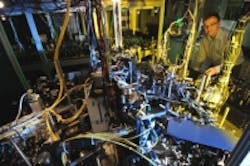Physicists from the Max Planck Institute of Quantum Optics used an EMCCD camera to monitor the behavior of quasi-crystalline "super atoms" created inside a giant, room-sized Quantum Simulator.
The Quantum Simulator took four years to build, and in it, the scientists created quasi-crystals by constraining rubidium atoms in optical lattices and exciting them to high-lying, long-range interacting atomic states. The resulting "super atom" creations obey the laws of quantum physics and are arranged simultaneously into different configurations, as if a single crystal would be graphite and diamond at the same time.
In order to acquire images of the atoms in the quasi-crystals, the scientists chose an Andor iXon 897 EMCCD camera. The iXon 897 features a 512 x 512 EMCCD sensor with a 16 µm x 16 µm pixel size and thermoelectric cooling down to -148°F. The USB 2.0 camera achieves a frame rate of 56 fps (full frame), and up to 11,074 fps at reduced resolutions.
"It is impossible to track the movement of individual electrons in a real solid, but quantum physics enables scientists to approach areas of science that at first glance may seem undefinable or defy our understanding entirely," said Dr Immanuel Bloch, Director at the Institute in an Andor press release.
With the Quantum Simulator, the team was able to study the solid state-like systems on the single particle level, as if one could image individual electronics in a solid, and the Andor iXon 897 was chosen to acquire these images.
"Observing how our crystal metamaterials form in the simulator is advancing our understanding of how these processes are driven in the real world," said Bloch. "It also facilitates completely new science, for instance in quantum computing, because we establish the parallel existence of different quantum states."
He added, “It is possible, in principle, to test simultaneously all the possible solutions to a problem and our simulator already allows us to observe quantum behavior that is beyond the capabilities of the world’s most powerful supercomputers."
View more information on the Andor iXon 897.
Also check out:
sCMOS cameras target scientific applications
Scientific CMOS cameras produce images of embryos in real time
EMCCD cameras used for ultra-cold atom research
Share your vision-related news by contacting James Carroll, Senior Web Editor, Vision Systems Design
To receive news like this in your inbox, click here.
Join our LinkedIn group | Like us on Facebook | Follow us on Twitter | Check us out on Google +
About the Author

James Carroll
Former VSD Editor James Carroll joined the team 2013. Carroll covered machine vision and imaging from numerous angles, including application stories, industry news, market updates, and new products. In addition to writing and editing articles, Carroll managed the Innovators Awards program and webcasts.

